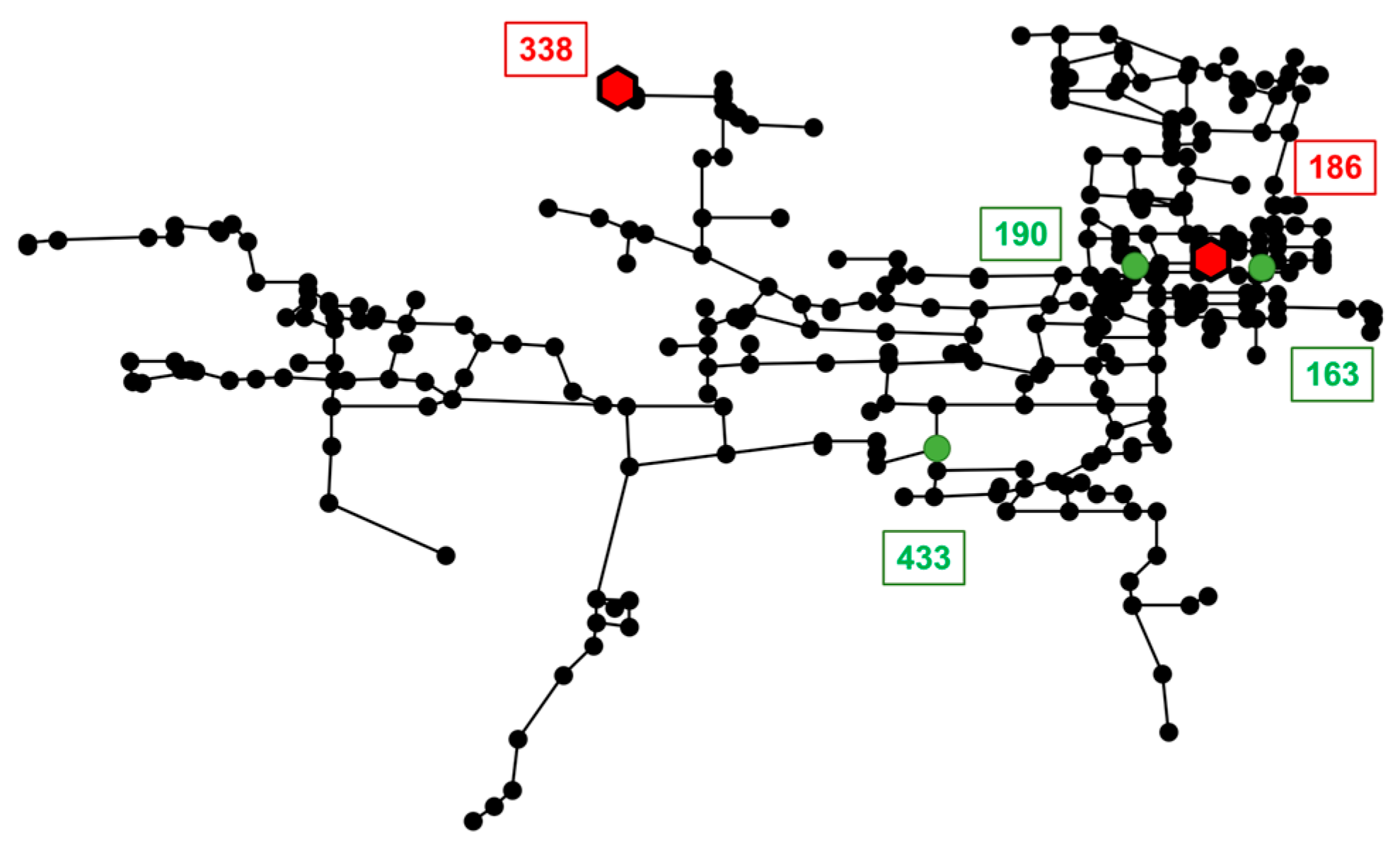Employing Extended Kalman Filter for Faulty Sensor Detection in Water Distribution Systems †
Abstract
1. Introduction
2. Methods
3. Results
4. Conclusions
Author Contributions
Funding
Institutional Review Board Statement
Informed Consent Statement
Data Availability Statement
Conflicts of Interest
References
- Xing, L.; Sela, L. Graph Neural Networks for State Estimation in Water Distribution Systems: Application of Supervised and Semisupervised Learning. J. Water Resour. Plan. Manag. 2022, 148, 04022018. [Google Scholar] [CrossRef]
- Zhou, X.; Zhang, J.; Guo, S.; Liu, S.; Xin, K. A convenient and stable graph-based pressure estimation methodology for water distribution networks: Development and field validation. Water Res. 2023, 233, 119747. [Google Scholar] [CrossRef] [PubMed]
- Yu, X.; Wu, Y.; Meng, F.; Zhou, X.; Liu, S.; Huang, Y.; Wu, X. A review of graph and complex network theory in water distribution networks: Mathematical foundation, application and prospects. Water Res. 2024, 253, 121238. [Google Scholar] [CrossRef] [PubMed]
- Zhou, X.; Liu, S.; Xu, W.; Xin, K.; Wu, Y.; Meng, F. Bridging hydraulics and graph signal processing: A new perspective to estimate water distribution network pressures. Water Res. 2022, 217, 118416. [Google Scholar] [CrossRef] [PubMed]
- Bartos, M.; Kerkez, B. Pipedream: An interactive digital twin model for natural and urban drainage systems. Environ. Model. Softw. 2021, 144, 105120. [Google Scholar] [CrossRef]
- Simon, D. Optimal State Estimation: Kalman, H Infinity, and Nonlinear Approaches; John Wiley & Sons: New York, NY, USA, 2006. [Google Scholar]
- Lu, J.; Liu, A.; Dong, F.; Gu, F.; Gama, J.; Zhang, G. Learning under Concept Drift: A Review. IEEE Trans. Knowl. Data Eng. 2018, 31, 2346–2363. [Google Scholar] [CrossRef]
- Boccelli, D. “02 PA 1”. US Systems. 2. 2016. Available online: https://uknowledge.uky.edu/wdst_us/2 (accessed on 26 March 2024).




Disclaimer/Publisher’s Note: The statements, opinions and data contained in all publications are solely those of the individual author(s) and contributor(s) and not of MDPI and/or the editor(s). MDPI and/or the editor(s) disclaim responsibility for any injury to people or property resulting from any ideas, methods, instructions or products referred to in the content. |
© 2024 by the authors. Licensee MDPI, Basel, Switzerland. This article is an open access article distributed under the terms and conditions of the Creative Commons Attribution (CC BY) license (https://creativecommons.org/licenses/by/4.0/).
Share and Cite
Huang, Y.; Thomas, M.; Bartos, M.; Sela, L. Employing Extended Kalman Filter for Faulty Sensor Detection in Water Distribution Systems. Eng. Proc. 2024, 69, 28. https://doi.org/10.3390/engproc2024069028
Huang Y, Thomas M, Bartos M, Sela L. Employing Extended Kalman Filter for Faulty Sensor Detection in Water Distribution Systems. Engineering Proceedings. 2024; 69(1):28. https://doi.org/10.3390/engproc2024069028
Chicago/Turabian StyleHuang, Yifan, Meghna Thomas, Matthew Bartos, and Lina Sela. 2024. "Employing Extended Kalman Filter for Faulty Sensor Detection in Water Distribution Systems" Engineering Proceedings 69, no. 1: 28. https://doi.org/10.3390/engproc2024069028
APA StyleHuang, Y., Thomas, M., Bartos, M., & Sela, L. (2024). Employing Extended Kalman Filter for Faulty Sensor Detection in Water Distribution Systems. Engineering Proceedings, 69(1), 28. https://doi.org/10.3390/engproc2024069028





